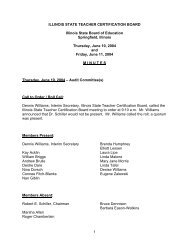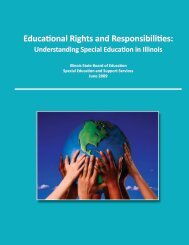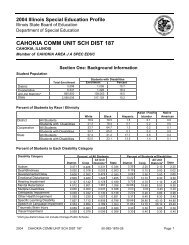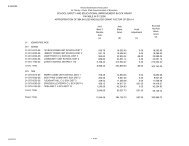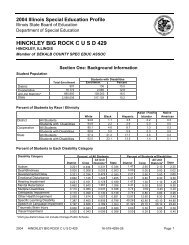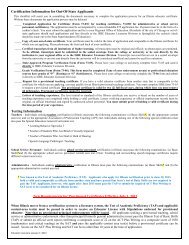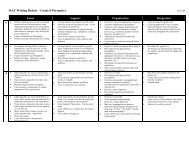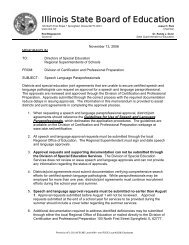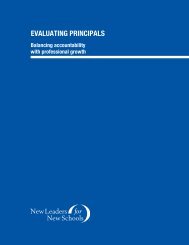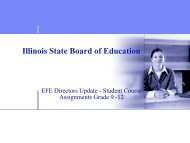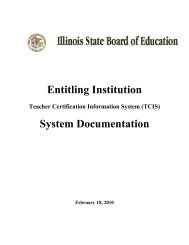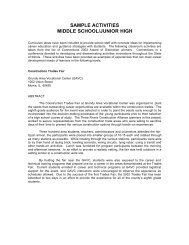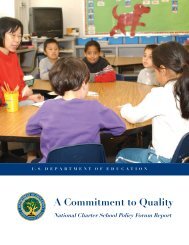Chicago Public School's Educational Facilities Task Force Findings ...
Chicago Public School's Educational Facilities Task Force Findings ...
Chicago Public School's Educational Facilities Task Force Findings ...
Create successful ePaper yourself
Turn your PDF publications into a flip-book with our unique Google optimized e-Paper software.
Illinois General Assembly’s<br />
<strong>Chicago</strong> <strong>Educational</strong> <strong>Facilities</strong> <strong>Task</strong> <strong>Force</strong><br />
February 2011<br />
Convened by Co-Chairs State Representative<br />
Cynthia Soto and Senator Heather Steans
Illinois <strong>Public</strong> Act 96-0803<br />
“Established the <strong>Chicago</strong> <strong>Educational</strong> <strong>Facilities</strong> <strong>Task</strong> <strong>Force</strong><br />
to ensure that school facility-related decisions are made<br />
with the input of the community and reflect educationally<br />
sound and fiscally responsible criteria.”<br />
*<strong>Chicago</strong> <strong>Educational</strong> <strong>Facilities</strong> <strong>Task</strong> <strong>Force</strong> also referred to as the “CEFTF”
The Process—since April 2010<br />
• 10 <strong>Task</strong> <strong>Force</strong> meetings (open to the<br />
public)<br />
• 4 Subcommittees, totaling more<br />
than 16 meetings:<br />
1. <strong>Public</strong> Input<br />
2. <strong>Facilities</strong> Master Planning<br />
3. CPS Policy Review<br />
4. Facility Needs, Spending &<br />
Funding<br />
• 3 <strong>Public</strong> Hearings with 257 attendees<br />
• 7 Focus Groups of 35 people (principals,<br />
teachers, parents, youth, organizations,<br />
elected officials [twice])<br />
• 16 written testimonies (5 via email)<br />
• Presentations by: CPS departments, 21 st<br />
Century School Fund, Renaissance School<br />
Fund, Academy for Urban School<br />
Leadership, City of <strong>Chicago</strong> Department of<br />
Community Development, IL Center for<br />
Violence Prevention.<br />
• Round 2 <strong>Public</strong> Hearings in February (3) to<br />
review and respond to recommendations<br />
Website for list of TF members, detailed info, meeting agendas and notes at:<br />
www.isbe.net/CEF
<strong>Public</strong> <strong>Findings</strong> on School Actions<br />
and Student Assignment<br />
School Actions<br />
• School actions have a disparate impact.<br />
• School actions have increased student violence.<br />
• CPS failed to provide a “Student Impact Assessment” for school actions.<br />
• School actions have affected some populations multiple times.<br />
• School actions do not always account for performance and learning.<br />
Student Assignment<br />
• New non-traditional schools and traditional attendance area neighborhood schools are<br />
not treated equitably.<br />
• New non-traditional school governing bodies lack public scrutiny and Local School<br />
Councils.<br />
• Attendance boundary decisions are often altered to exclude or include a particular group.<br />
• New schools may exclude the most underserved children and/or have greater choice in<br />
determining which students it enrolls (i.e. high needs, lowest performing, behavioral<br />
students often excluded).
<strong>Public</strong> <strong>Findings</strong> on Planning, Spending, <strong>Public</strong><br />
Engagement and Accountability<br />
Facility Master Planning and Capital Spending<br />
• There is no clear process or accountability for how decisions are made on school actions, school<br />
openings, and school capital investment and new construction strategies.<br />
• There are inequities in capital expenditures.<br />
• The public does not have access to information about planned capital projects or the criteria for<br />
setting capital funding priorities.<br />
<strong>Public</strong> Engagement<br />
• CPS lacks a clear, transparent parent and community process for making educational facility<br />
decisions.<br />
• Parent and community voices are often ignored and not-validated even if accurate.<br />
• Decisions do not weigh student interests and opportunities as the most important.<br />
Governance and Accountability<br />
• CPS fails to follow its own policies on school actions.<br />
• CPS lacks transparency and a clear process for decisions on building new schools, and selling, leasing, and<br />
related facility decisions.<br />
• There is no system of oversight of capital plans or spending.<br />
Other<br />
• Overlying themes related to decisions and actions: race, demographics, utilization, co-sharing,<br />
gentrification, money, community development house, CHA Plan for Transformation, public participation,<br />
facility repairs, student assignment, academic performance, attendance boundaries, transportation, and<br />
safety.<br />
• There is a negative stigma of students and educators from closed schools that creates difficulties for students<br />
in transferring and educators in hiring.
Testimony from the <strong>Public</strong><br />
• Abbott was not failing academically, but<br />
was closed for underutilization. The<br />
current school action policy allowed the<br />
designated receiving school for Abbott to<br />
be lower performing. The building is now<br />
occupied by Air <strong>Force</strong> Academy and is even<br />
more underutilized than before.<br />
• Raymond was underutilized. Today<br />
Perspectives Charter operates inside their<br />
building, still underutilized by CPS<br />
standards.<br />
• The performing Carpenter students were<br />
phased out for underutilization, and the<br />
Ogden expansion moved in with new<br />
capital spending to support their school.<br />
• Gladstone received students from<br />
Jefferson and Riis; years later it closed<br />
after redevelopment displaced housing.<br />
• Andersen School was performing, but was<br />
phased out for a new LaSalle Magnet II<br />
where existing Andersen students were<br />
excluded. They shared the building during<br />
a phase out and witnessed CPS invest in the<br />
new LaSalle Magnet II.<br />
• Neighborhood students lose access to new<br />
schools:<br />
• Albany Park was turned over to a<br />
charter.<br />
• Westinghouse is part-selective<br />
enrollment.
The <strong>Public</strong>’s Questions<br />
• Why did Jones College Prep receive<br />
$23.6 million for major building<br />
improvements AND a $106 million for<br />
a new school?<br />
• Attucks experienced an emergency<br />
closure in spite of regular building<br />
assessments. Now students are bussed<br />
to an empty school across the street<br />
from another neighborhood school,<br />
maintaining its attendance<br />
boundaries. What happens to the old<br />
vacant building? Will attendance<br />
boundaries always be for a school<br />
outside of them with bussing?<br />
• Why haven’t chronic overcrowding<br />
and poor conditions<br />
at Gallistel been addressed?<br />
• When will Stowe get the repairs it<br />
needs?<br />
• How are new construction and<br />
other priorities really<br />
determined, and how are needs<br />
among schools balanced across<br />
the entire school district?<br />
• Who is actually determining<br />
how to rank and prioritize CPS’<br />
capital investment s?
Of <strong>Chicago</strong> <strong>Public</strong> School Data<br />
Mary Filardo, Executive Director<br />
21 st Century School Fund, Washington, DC<br />
www.21csf.org<br />
(202) 745-3745
Utilization—A key factor in closings<br />
• According to CPS:<br />
• Capacity of the <strong>Chicago</strong> <strong>Public</strong> School system’s<br />
school buildings is 630,460 students<br />
• 2010-2011 enrollment is 402,426 as of Dec 1,<br />
2010<br />
• CPS identifies its district wide utilization at 64%
Analysis of Capacity and Utilization<br />
• Capacity is a function of program—class size, school size,<br />
special education services offered, early childhood<br />
education, science, music, library and other specialty<br />
spaces available, as well as the efficiencies of the building<br />
itself.<br />
• A modern definition of CPS capacity vs utilization would<br />
indicate that the district needs an average (over all grades<br />
and types of schools) of 150 gross square feet per student to<br />
meet educational program requirements.<br />
• <strong>Chicago</strong> <strong>Public</strong> Schools, currently operates with an<br />
average of 96 gross square feet per student.
Comparing CPS Space per Sq Ft<br />
Standards to the Nation<br />
200<br />
180<br />
160<br />
140<br />
120<br />
100<br />
80<br />
60<br />
40<br />
20<br />
0<br />
Median High Quartile Top 10% CPS<br />
Source: 15 th Annual School Construction Report, School Planning and Management, Table 5,<br />
February 2010
Flawed Standards for CPS Capacity<br />
• CPS identifies 224 schools as utilizing less than 50% of<br />
their ‘capacity’—but there is clearly a problem:<br />
School<br />
CPS<br />
Capacity<br />
Enrollment<br />
2010-11<br />
% Utilized<br />
per CPS<br />
Bldg GSF<br />
Actual GSF/<br />
Student<br />
GSF if using<br />
capacity<br />
Clark PK-8th 856 324 37 43,600 135 51<br />
Brown Academy 855 331 38 36,400 110 43<br />
Courtenay 465 215 46 29,400 137 63<br />
Esmond 1110 396 35 72,600 183 65<br />
• Not all schools are fully utilized, but CPS’ formula<br />
doesn’t accurately identify which ones are and by how<br />
much.
<strong>Chicago</strong> <strong>Public</strong> School Capital<br />
Spending 1996-2010<br />
• <strong>Chicago</strong> <strong>Public</strong> Schools spent approximately $4.6 billion in<br />
capital projects since 1996.<br />
• There are another $1.4 billion of projects in progress or planned<br />
through the ‘Modern Schools Across <strong>Chicago</strong>’ Initiative (paid for<br />
by City of <strong>Chicago</strong> TIF funds).<br />
• Criteria for capital spending priorities were undefined:<br />
• Over half ($625 million) of the nearly $1.14 billion in<br />
capital funds spent from FY2006-2010 was spent on only<br />
67 of 603 <strong>Chicago</strong> <strong>Public</strong> Schools.<br />
• No capital funds were spent in 330 <strong>Chicago</strong> <strong>Public</strong><br />
Schools between FY2006-2010.<br />
*As of 4/16/2010; Analyzed by 21 st Century School Fund in Washington, DC.
Current Facility Needs Assessment<br />
Compared to 2006-2010 Spending<br />
• CPS says that correcting problems identified as “Phase 1 and<br />
Phase 2” deficiencies are its top priorities.<br />
• 43% ($457 of $835 million) of Phase 1 , Exterior Envelope<br />
(Roof, Masonry, Windows) - were addressed.<br />
• 16% ($302 million of $1.8 billion) of Phase II, the MEP<br />
(Mechanical, Electrical, Plumbing) - needs were addressed.<br />
• 31% ($503.8 million of $1.6 billion) of the Phase III, Interiors<br />
and Program Enhancements - were addressed.<br />
• 12% ($36 of $311 million) of the Phase IV, Site (Landscaping,<br />
Parking, Athletic Fields) - needs were addressed.
Tremendous Facility Needs<br />
• 92 CPS schools need an average of $137 per square<br />
foot—a total of $750 million—to bring them into<br />
good repair.<br />
• 44,095 students attend these schools<br />
• 85% are eligible for free or reduced priced lunch<br />
• 12.1% are special education students<br />
• 12.8% are English Language Learners<br />
• The average square ft per student in these schools is 139<br />
SF (so these schools are not under-utilized by national standards)<br />
• The average capital investment still needed in the other<br />
schools is much lower - $51 per square foot.
The Bottom Line<br />
• Money is being spent all the time without a plan.<br />
• There are significant winners, but too many schools and<br />
students are chronically ‘left behind’ with extremely high<br />
facility needs.<br />
• School actions are based on performance, capital, or<br />
utilization criteria that shift from year to year,<br />
• but utilization and needs assessments are flawed; criteria<br />
are applied inconsistently across the city, and CPS capital<br />
spending is neither transparent or accountable.<br />
• An analysis of CPS’ own data supports the public’s findings.
CEFTF’s Summary of Analysis<br />
• After spending $4.6 billion, how<br />
is it that we still have 92 schools<br />
in such poor condition with<br />
facility repair needs?<br />
• Priorities for fixing schools<br />
compared with building new<br />
schools are not clear.<br />
• Schools’ facility needs<br />
assessments and CPS spending<br />
need to be aligned to address<br />
what schools need compared to<br />
what they received.<br />
• Money was spent to repair or<br />
modernize schools that were<br />
then demolished or closed.<br />
• There is evidence of unexplained<br />
disparities: Inequitable<br />
spending varying widely from<br />
school to school.<br />
• CPS school utilization<br />
information is flawed, yet drives<br />
crucial decisions.<br />
• Allocating spending so that<br />
“everyone got something” is not<br />
always driven by need.
<strong>Task</strong> <strong>Force</strong> Preliminary<br />
Recommendations<br />
• Facility-related decisions must be aligned with educational goals and<br />
based on the students well-being and learning first.<br />
• CPS should be required to have a 10-year long-range Facility Master<br />
Plan -- developed in collaboration with community, parents, LSCs,<br />
educators and other stakeholders.<br />
• Transparency must exist through access to accurate and welldocumented<br />
information in capital spending, assessments, actions,<br />
and openings .<br />
• Decisions should be collaborative, inclusive, and accountable.<br />
• A Citizen Oversight Panel will ensure accountability and governance.<br />
• School actions -with the existing students ‘ interests as a priority -<br />
must be accompanied by clear, convincing evidence and an<br />
<strong>Educational</strong> Impact Statement (EIS).
Soliciting More Feedback<br />
• <strong>Public</strong> Hearing Dates:<br />
• Friday, February 18, 2011, 10:00 AM – Noon<br />
Bilandic Bldg Auditorium, 160 N. LaSalle 5 th Floor<br />
• Wednesday, February 23, 2011, 5:30 - 7:30pm<br />
Northern Trust Bank, 7801 S. State Street<br />
• Thursday, February 24, 2011, 5:00 – 7:30pm<br />
Roberto Clemente HS, 1147 N. Western Avenue<br />
• Written feedback will be received until 5 PM, TUESDAY,<br />
March 8, 2011.<br />
• Go to ISBE website to review Recommendations and download a<br />
Feedback Form: www.isbe.net/CEF<br />
• Complete the Feedback Form or share general comments. Submit it<br />
via fax or email:<br />
• Email: ceftf.publicinput@gmail.com<br />
• Fax: <strong>Public</strong> Input Co-Chair, Valencia Rias @ 312-236-7927



